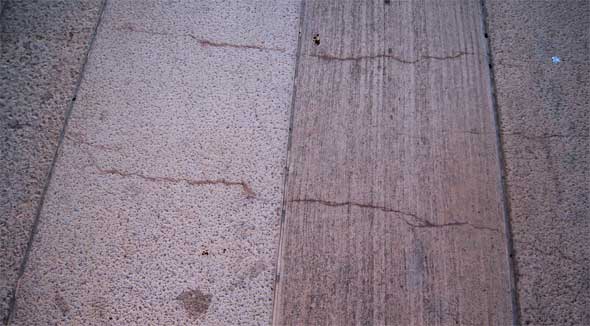The New Concrete “Boardwalk” Is Already Cracking

THE COMMUTE: This week’s Commute is for those of you who walk or run on the Riegelmann Boardwalk, which is in danger of extinction as we know it. The latest proposal calls for a 12-foot wide concrete strip for motorized vehicles, yielding to opposition from those who opposed a boardwalk entirely made of concrete. Now here is the latest development.
The new concrete boardwalk, laid last year, has already developed numerous hairline cracks after only one winter. The 300-foot segment between Ocean Parkway and Brighton 1
stRoad is already showing signs of age, although the city favored concrete over choices such as natural wood, kebony-treated wood and recycled plastic lumber. Also, the concrete is staining and shows off gum spots remarkably well.
The City Lies
This all flies in the face of the city’s claims that concrete was the most sturdy and economical choice and would last virtually forever, something they suggested on multiple occasions.
“Concrete is less expensive to use, can last decades rather than up to 10 years, and requires virtually no maintenance,” Parks Spokesperson Meghan Lalor said last fall. “It is significantly more effective than the other choices.”
Brooklyn Parks Commissioner Kevin Jeffrey said the material costs less, is not slippery, is easier to repair and is less likely to break or rot than its alternatives. There was no mention as to how snow would be removed or if the concrete walk would be salted or plowed and how much wear and tear that would cause.
In actuality, the wood in use now was guaranteed for 20 years with some sections lasting as few as 12 years – not 10 as the city asserted. The problem with wood, however, is that much of it came from tropical rain forests, justifiably sparking opposition from environmentalists. But the city’s opposition to other materials seems a little less substantial.
The makers of Recycled Plastic Lumber claim it can last as long as 50 years, but the city says the material is too slippery when wet. I walked on the small section installed along Steeplechase Pier and can tell you it is also slippery even when dry. Apparently the original wood grain texture giving it some traction has already worn away leaving an ultra-smooth surface. Also, I do not understand why the slats were installed with no space between for the water to drain. But, overall, these are issues that can be remedied with minor design tweaks.
Recently two groups have sprouted to preserve the Riegelmann Boardwalk: Todd Dobrin’s Friends of the Boardwalk, and Rob Burstein’s Coney-Brighton Boardwalk Alliance, which is circulating an online petition.
What Should Be Done?
Concrete apparently is not as durable as the city claimed it would be because the hairline cracks will only get worse with age and eventually will have to patched – unless, of course, the city wants to be faced with huge lawsuits, since falls on concrete are much more severe than falls on wood. Concrete is also criticized because it is more difficult to walk or run on than wood and that it is hotter than wood to walk on with bare feet. I am in favor of the recycled plastic lumber as long as a variety can be found that will not become slippery after only a few years, and if it could be installed to look like the traditional boardwalk. I do not believe we should have to destroy the rain forest to obtain a lumber that is usable for the boardwalk. Other varieties such as kebony-treated lumber should be considered. However, the makers of kebony have not come forth to show that pricing is economically feasible as they have alleged.
What I Think Will Happen
A small section composed of recycled plastic lumber with a concrete driving strip will be constructed. The city will not acknowledge the fact that concrete is not holding up as intended, but will state after a year that recycled plastic lumber is too slippery and not suitable for further use, and will revert to their original plan to complete the remainder of the boardwalk (except for five blocks within the amusement area which they may increase to 10) entirely of concrete. They will buy the cheapest grade of recycled plastic lumber on the market to ensure that it fails, and will make no attempt to find a type that will not get slippery or wear out too fast. They also will do no investigation of using non-tropical woods or kebony (or similarly treated) wood.
The Commute is a weekly feature highlighting news and information about the city’s mass transit system and transportation infrastructure. It is written by Allan Rosen, a Manhattan Beach resident and former Director of MTA/NYC Transit Bus Planning (1981).




